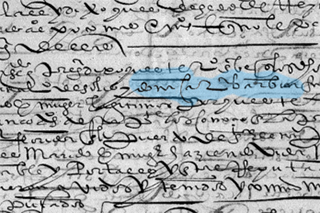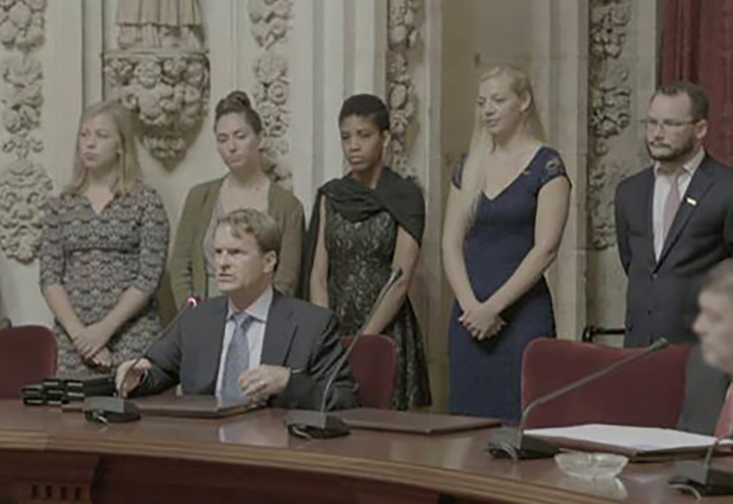Two young USF St. Petersburg history scholars are reading 16th century Spanish, scrolling through documents in one of the world’s most important historical archives and making a huge impact on how the story of colonial Florida is told.
For more than 10 years, Dr. J. Michael Francis, the Hough Family Endowed Chair of Florida Studies and Professor of History at USF St. Petersburg, and his team of students have been combing through thousands of historical documents to shed light on a largely forgotten period and place in American history, Spanish colonial Florida. His decade-worth of research has contributed to La Florida: The Interactive Digital Archive of the Americas. This project covers the time period spanning from the early 1500s to the start of the 1800s. On early maps, the geographical area La Florida covered was far more than what we know Florida to be today; it extended from the Florida Keys north to Newfoundland and as far west as the Mississippi River.
Access La Florida: The Interactive Digital Archive of the Americas.
Rachel Sanderson and Hannah Tweet, both associate directors for La Florida, have been integral in the development of Dr. Francis’ vision and instrumental in the project coming to fruition.
The rise of new technology allows La Florida to become a direct connection between international archives and the public. With nearly real-time updates on data that continues to be uncovered, this interactive website will provide the most up-to-date, exciting and challenging historical material available to historians, students and the public.
“We are working to engage a global audience,” Sanderson said. “We want to ensure that our site will wow people, because the information is worthy of that.”
In 2013, Sanderson was finishing her second bachelor’s degree at USFSP when she learned about a master’s course in paleography, which specifically focused on learning to read 16th century Spanish script. Taking the course included the prospect of travelling to Seville, Spain and conducting research at the famous Archivo General de Indias, (General Archive of the Indies), the repository of extremely valuable documents of the Spanish Empire in the Americas and the Philippines, and home to most documents related to Colonial Florida.
“I thought, of course I should get my master’s degree and have this experience!” Sanderson said. “Dr. Francis presented me with the opportunity to help build this collaborative, interactive website where primary documents are available. I jumped on board.”
Sanderson now has an MLA in Florida Studies, focusing on Colonial Spanish Florida, and has been working on La Florida for four years.
Tweet, a Washington state native, moved to St. Petersburg in fall 2016, to enroll in the Florida Studies master’s program.
“I came to USFSP specifically to work with Dr. Francis,” Tweet said, “I knew I would get good training, plus the opportunity to conduct archival research in Spain.”
Tweet secured a graduate research assistantship as part of her acceptance package.
“The data set I was given was on a Spanish expedition to Florida in 1566,” Tweet said. “I was just given this data set and told, ‘go!’ That was the birth of my interest in La Florida, and that same data set became a major part of our project.”
The data set came from Dr. Francis’ research notes on every name he discovered on the Archiniega expedition in 1566 – the voyage that arrived in St. Augustine one year after its founding. With over 2,000 individuals, it was one of the largest Spanish fleets to ever sail for Florida. Information Dr. Francis documented of those on the expedition included: individuals’ names, occupations, literacy rates, what they ate and drank, what company soldiers served in and what type of soldier they were. There were also a few women who showed up – wives, single women and women who didn’t have a license to be on the expedition.
“What was rewarding to me about this mix of data, that appears mundane at first glance, was the larger picture that emerged,” Tweet said. “That’s what gets me excited – the big-picture, a comprehensive view of this group of people and what we can learn about them.”
Before Sanderson and Tweet could travel to Spain to conduct research, they had to complete courses in Spanish paleography, and be trained in how to study the documents they would find at the Seville archive.

A portion of a primary document (the letters highlighted in blue are an abbreviation for the petitioner’s name, doña Catalina Barbón).
“My first trip to Spain was both a test and training,” Sanderson said. “It was fantastic, but I got there thinking I was ready to tackle the world, and it was quite a different experience. Dr. Francis does a great job preparing students for this encounter, but it was still a wake-up call for me.”
Sanderson realized during that trip she needed more training in Spanish.
“The next year I decided to go by myself and I was forced to speak only Spanish. That was a great experience,” she said. “I am still learning, but part of what draws me to the project is the challenge of making what seems impossible, happen.”
Tweet’s first trip to Spain was last summer, spending two months researching in Seville.
“Having the documents in front of me was exciting,” Tweet said. “But finding something interesting within a document was thrilling!”
For Tweet, finding new names, deciphering name abbreviations or literacy rates to add to the La Florida database was hard work but these seemingly small bits of data were the biggest treasure.
The research and data collection Sanderson, Tweet and Dr. Francis have been working tirelessly on over the past few years will be unveiled on March 15, in Washington D.C. and available to the world via La Florida’s interactive website. The project comprises data from when Spaniards first arrived in Florida around 1513 to when Florida became a United States territory in 1821.
“It’s crunch time. We are making sure we have everything together and our data is clean,” said Sanderson. “We are not determining what people need to know, but providing all the information we have, so they can research and discover what interests them.”
Preparing La Florida’s interactive website for its big launch reaches far beyond historical research and translating and transcribing 16th century Spanish script for the young historians. Sanderson and Tweet have also produced material for kids, written video scripts, articles and book chapters, created images for short movies, designed web pages, and even fundraised and conducted public presentations.
“I get to be part of something much bigger than I could have ever imagined,” Tweet said. “It is rewarding and an honor.”
(Article by Karlynd June, USFSP Content Specialist)
